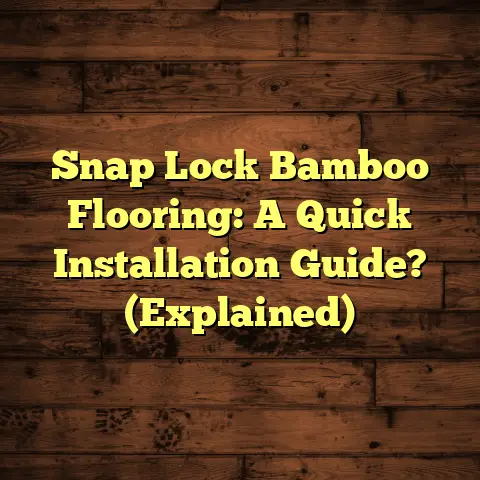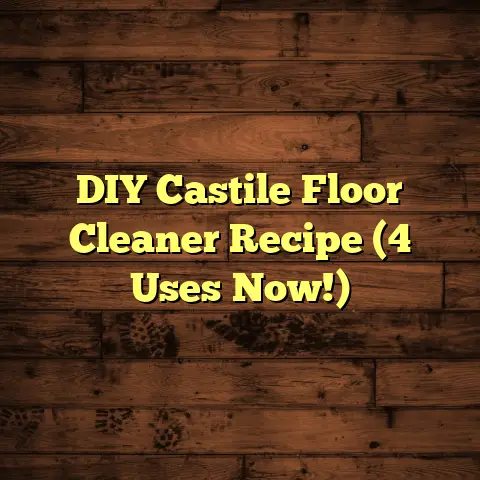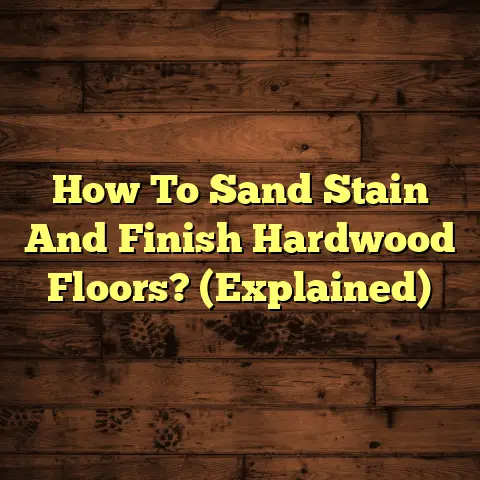Stop Rugs Slipping On Hardwood? (7 Fixes Needed!)
As a flooring contractor, I see a lot of homes go through seasonal transformations. With spring in the air, many homeowners refresh their spaces. Lighter colors, breezy fabrics, and maybe a new area rug to brighten things up.
Then comes winter. Out come the cozy, thicker rugs for added warmth. Rugs are fantastic for adding style and comfort to hardwood floors, right? But let’s face it, that slipping rug can be a real pain and a safety hazard.
I’ve seen firsthand how a simple slip can lead to nasty falls. It’s not just about preventing accidents, though. It’s also about protecting your beautiful hardwood floors.
A rug constantly shifting can cause scratches and wear over time. So, how do we keep those rugs in place and our floors looking pristine? Stick with me, and I’ll share some of my tried-and-true methods.
We’ll dive into why rugs slip in the first place, and then I’ll walk you. Through seven effective fixes that I use on the job all the time. Let’s make your home safer and more stylish, shall we?
Section 1: Understanding the Problem
Why do rugs slip on hardwood floors anyway? It’s a simple matter of physics, really. Hardwood has a smooth surface. Rugs, especially those with slick backings, just don’t have enough friction to grip.
Think of it like trying to ice skate on a freshly polished floor – slippery! The materials of the rug and the floor just don’t want to play nice. I often see rugs shifting in high-traffic areas like hallways or living rooms.
Under furniture, you might think they’re secure, but even there, they can creep. Homes with pets and kids? Forget about it! Those rugs are practically begging to become tripping hazards.
I remember one client who had a beautiful Persian rug in her entryway. Every time someone came in, the rug would inch forward. One day, she tripped and sprained her wrist.
According to the CDC, falls are a leading cause of injury in the US. And while not all falls are rug-related, slipping rugs definitely contribute. (Source: Centers for Disease Control and Prevention).
In fact, a study by the National Safety Council found that flooring. And flooring materials contribute to over 2 million fall injuries annually. (Source: National Safety Council).
It’s not just about the falls, though. A slipping rug can bunch up, creating a tripping hazard. It can also damage the rug itself, causing it to wear unevenly.
Plus, constantly readjusting a rug is just plain annoying, am I right? So, let’s get to the bottom of this and find some real solutions. Ready to dive into the fixes? Let’s go!
Section 2: Fix #1 – Non-Slip Rug Pads
Alright, let’s talk about the first and often most effective solution: Non-slip rug pads. These are game-changers, trust me. Think of them as the unsung heroes of the flooring world.
Basically, a rug pad sits between your rug and the hardwood floor. It provides grip, preventing the rug from sliding around. But not all rug pads are created equal.
You’ve got a few different types to choose from: rubber, felt, and combination pads. * Rubber pads are great for providing a strong grip. They’re usually made. From natural or synthetic rubber and have a textured surface. Perfect for preventing slippage on smooth floors.
-
Felt pads are a bit thicker and add extra cushioning under your rug. They’re not as grippy as rubber, but they do a good job of protecting. Your hardwood floor from scratches and dents.
-
Combination pads offer the best of both worlds. They usually have a felt top for cushioning and a rubber bottom for grip.
So, how do you pick the right one? Well, it depends on a few factors: * Rug size: Make sure the pad is slightly smaller than the rug. So it doesn’t peek out from underneath.
-
Rug thickness: If you have a thick rug, a thinner pad might be fine. But for thinner rugs, a thicker pad can add some much-needed comfort.
-
Type of hardwood flooring: Some hardwood finishes are more delicate. You will want a pad that won’t stain or damage the finish.
I always recommend natural rubber pads for delicate floors. They’re less likely to react with the finish. To install a rug pad, simply lay it out on the floor where you want the rug to go.
Then, place the rug on top of the pad. Make sure the pad is centered and trimmed if necessary. For maintenance, vacuum the pad regularly to remove any dust or debris.
I had a client with a brand-new maple floor who was worried about scratching it. I recommended a felt and rubber combination pad. She was thrilled with how well it protected her floors and kept the rug in place.
Investing in a good quality rug pad is worth it. It protects your floors, prevents accidents, and extends the life of your rug. Plus, it makes vacuuming a whole lot easier.
Section 3: Fix #2 – Carpet Tape
Now, let’s talk about a quick and cost-effective solution: carpet tape. This stuff is like the duct tape of the flooring world – super versatile. Carpet tape is a double-sided adhesive tape that you can use to secure rugs.
To hardwood floors. It’s a pretty straightforward concept, right? There are a few different types of carpet tape available: * Double-sided tape: This is the most common type. It has adhesive on both sides and is designed to stick to both. The rug and the floor.
-
Adhesive tape: This type has a stronger adhesive and is designed. For more permanent installations. I don’t usually recommend it for rugs. On hardwood floors, as it can be difficult to remove.
-
Residue-free tape: This tape is designed to leave minimal residue. When removed. It’s a good option for delicate hardwood finishes.
Here’s how to apply carpet tape to keep your rugs in place: 1. Clean the floor: Make sure the hardwood floor is clean and dry. Before applying the tape. Use a mild cleaner and a soft cloth.
-
Cut the tape: Cut the carpet tape into strips that are a few inches long. You’ll need enough strips to cover the perimeter of the rug. And a few extra for the middle.
-
Apply the tape: Peel off one side of the tape and stick it. To the back of the rug. Place the strips along the edges of the rug. And a few in the center.
-
Position the rug: Carefully position the rug on the hardwood floor. Make sure it’s in the desired location.
-
Press down: Press down firmly on the rug to ensure the tape adheres. To the floor.
Carpet tape is a great option for small rugs or rugs in low-traffic areas. But it does have some drawbacks. Over time, the adhesive can break down, causing the rug to slip again.
It can also leave a sticky residue on your hardwood floor when removed. To remove carpet tape residue, try using a mild adhesive remover. Or a mixture of warm water and dish soap.
Always test the remover on a small, inconspicuous area first to make sure. It doesn’t damage the finish. I once used carpet tape to secure a small bathroom rug for a client.
It worked great for a few months, but eventually, the tape started to lose. Its grip, and the rug started to slip again. She ended up switching to a non-slip rug pad, which worked much better.
Carpet tape can be a good temporary solution. But for long-term rug security, I usually recommend something more robust. Like a rug pad or Velcro strips.
Section 4: Fix #3 – Velcro Strips
Let’s explore another creative solution for keeping rugs in place: Velcro strips. Yes, the same stuff you use on your shoes can work wonders on rugs! Velcro strips consist of two parts: a hook side and a loop side.
When pressed together, they create a strong, secure bond. You can apply Velcro strips to both the rug and the floor to keep it from slipping. Here’s a detailed installation guide:
Materials Needed: * Velcro strips (available at most hardware or craft stores) * Scissors * Measuring tape * Cleaning supplies (for the floor and rug) * Optional: Adhesive promoter for the floor
Best Practices: 1. Prepare the Surfaces: Start by cleaning both the back of the rug. And the area of the hardwood floor where the rug will be placed. Remove any dust, dirt, or debris.
-
Measure and Cut: Measure the perimeter of your rug and cut the Velcro. Strips to the appropriate length. You’ll need enough strips to cover. The entire perimeter, as well as a few for the center of the rug.
-
Apply to the Rug: Peel off the backing from the adhesive side of the hook. Strips and attach them to the back of the rug. Space them evenly. Around the edges and in the center.
-
Apply to the Floor: Peel off the backing from the adhesive side of the loop. Strips and attach them to the hardwood floor. Align them with the hook. Strips on the rug.
-
Secure the Bond: Press the rug firmly onto the floor, ensuring that the hook. And loop strips engage. Apply pressure for a few seconds to create. A secure bond.
Velcro can be particularly advantageous in situations where you need to be. Able to remove the rug easily for cleaning or rearranging furniture. It’s also great for rugs that tend to shift a lot, as the Velcro provides. A strong, reliable hold.
However, Velcro may be less effective on very thick or heavy rugs. As the adhesive may not be strong enough to hold them in place. It’s also important to choose high-quality Velcro strips with a strong adhesive.
To avoid damaging your hardwood floor. I once used Velcro strips to secure a large area rug in a living room. The client had tried everything to keep the rug from slipping.
But nothing seemed to work. The Velcro strips did the trick. The rug stayed firmly in place, and the client was thrilled. Just be sure to test a small area first to ensure the adhesive doesn’t damage.
Your floor’s finish. So, if you’re looking for a reliable and versatile solution for keeping. Your rugs in place, give Velcro strips a try. You might be surprised. At how well they work!
Section 5: Fix #4 – Area Rug Grippers
Let’s dive into another specialized product designed to keep rugs in place: Area rug grippers. These are like little superheroes for your rugs. They come in various styles, each with its own unique way of holding.
Your rugs in place. Some adhere to the floor, while others adhere to the rug. Here’s a rundown of the different types available: * Adhesive Grippers: These grippers have an adhesive backing that sticks. To both the rug and the floor. They provide a strong, secure hold. But can sometimes leave a residue when removed.
-
Non-Adhesive Grippers: These grippers use a textured surface or a rubberized. Material to grip both the rug and the floor. They’re less likely to leave. A residue, but may not be as strong as adhesive grippers.
-
Corner Grippers: These small, triangular grippers are designed to fit. Under the corners of your rug. They’re great for preventing the corners. From curling up or slipping.
Choosing the right gripper depends on a few factors: * Rug Size: Make sure the grippers are the right size for your rug. Larger rugs will need more grippers than smaller rugs.
-
Rug Type: Thicker rugs may require stronger grippers. While thinner rugs may be fine with less aggressive options.
-
Floor Type: Some grippers are designed for specific types of flooring. So make sure to choose one that’s compatible with your hardwood floors.
I’ve had clients rave about how well area rug grippers work. One client told me that she had tried everything to keep her entryway rug. From slipping, but nothing seemed to work until she installed area rug grippers.
She said that the grippers were easy to install and that they held the rug. Firmly in place, even with heavy foot traffic. Another client said that she loved how the corner grippers prevented her rug.
From curling up, which had been a major tripping hazard. Here’s a tip: When installing area rug grippers, make sure to clean. Both the rug and the floor thoroughly before applying the grippers.
This will help ensure a strong, secure bond. Also, be sure to follow the manufacturer’s instructions carefully. For best results.
Area rug grippers can be a great solution for keeping your rugs. In place, but it’s important to choose the right type and install them properly. With a little bit of research and effort, you can say goodbye to slipping rugs.
Section 6: Fix #5 – Furniture Placement
Now, let’s talk about a solution that doesn’t involve any extra products. Strategic furniture placement. Sometimes, the best way to keep a rug. In place is to simply weigh it down with furniture.
This is especially effective in larger rooms where you have more flexibility. With your furniture arrangement. Here are a few tips for using furniture. To anchor your rugs:
-
Place furniture legs on the rug: The most obvious way to anchor a rug. Is to place the legs of your furniture on top of it. This works best with. Sofas, chairs, and coffee tables.
-
Use heavy furniture: Heavier pieces of furniture, like bookcases or sideboards. Will provide more stability than lighter pieces.
-
Create boundaries: Use furniture to create boundaries for your rugs. For example, you can place a sofa along one edge of the rug to prevent. It from sliding forward.
Consider foot traffic patterns when arranging your furniture. If people tend to walk across a certain area of the rug, try placing. A piece of furniture in that area to weigh it down.
I once helped a client rearrange her living room to better anchor her area rug. We placed the front legs of her sofa and chairs on the rug. And positioned a heavy coffee table in the center.
The rug stayed firmly in place, even with her kids running around. She was amazed at how much of a difference it made. Furniture placement can also help define different zones within a room.
For example, you can use a rug to anchor a seating area in a living room. Or to define a dining area in an open-concept space. Just be careful not to overcrowd the rug with too much furniture.
You want to leave enough of the rug exposed to showcase its design. And create a comfortable walking surface. So, before you spend money on rug pads or tape, try rearranging.
Your furniture to see if that does the trick. You might be surprised. At how effective this simple solution can be. It’s free, it’s easy, and it can make a big difference in the stability.
Of your rugs. Plus, it gives you a chance to refresh your room’s layout!
Section 7: Fix #6 – Weighing Down Rugs
Let’s explore another practical solution for keeping rugs from shifting: Weighing them down. This involves using various items to add weight. To the rug, preventing it from sliding around.
While furniture is a great option, there are other creative ways to weigh. Down rugs without compromising your home decor. Here are a few ideas: * Decorative Weights: You can find decorative weights specifically. Designed for this purpose. These weights come in various shapes, sizes. And materials, so you can choose ones that complement your style.
-
DIY Solutions: Get creative and make your own rug weights. You can fill small bags with sand or pebbles and cover them with fabric. That matches your rug.
-
Furniture Risers: Place furniture risers under the legs of your furniture. To add height and weight. This can also make it easier to clean. Underneath the furniture.
Integrating weights into your home decor can be a fun and creative challenge. Try placing decorative weights along the edges of your rug. Or tucking them under furniture legs.
You can also use heavy books or magazines as makeshift weights. Just make sure they’re protected from moisture and won’t damage the rug. I once helped a client who had a beautiful antique rug that kept slipping.
She didn’t want to use rug pads or tape, as she was worried about damaging. The rug. We decided to use decorative weights to keep it in place. We found some elegant brass weights that complemented the rug’s design.
And placed them along the edges. The weights not only kept the rug. From slipping but also added a touch of sophistication to the room. When choosing weights for your rugs, consider the size and weight.
Of the rug, as well as the amount of foot traffic it receives. Larger, heavier rugs will require more weight than smaller, lighter rugs. Also, make sure the weights are evenly distributed to prevent the rug.
From bunching up or becoming uneven. Weighing down rugs can be a simple and effective way to keep them. In place, especially if you’re looking for a non-invasive solution.
Get creative, experiment with different types of weights, and find what works. Best for your rugs and your home decor.
Section 8: Fix #7 – Choosing the Right Rug
Finally, let’s talk about the importance of choosing the right rug. To minimize slipping in the first place. The material, backing, and design. Of a rug can all affect how likely it is to slide on hardwood floors.
Here are a few things to look for when shopping for rugs: * Material: Rugs made from natural fibers like wool or cotton tend to be. Less slippery than those made from synthetic materials like polyester. Or nylon.
-
Backing: Look for rugs with a non-slip backing, such as latex or rubber. These backings provide extra grip and prevent the rug from sliding around.
-
Design: Rugs with a low pile or a flat weave are less likely to slip than rugs. With a high pile or a shag texture.
I always recommend choosing rugs with a non-slip backing for hardwood floors. These rugs are specifically designed to stay in place and prevent accidents. If you already have a rug that you love but it doesn’t have a non-slip backing.
You can always add a rug pad or use one of the other fixes we’ve discussed. When shopping for rugs, consider both safety and aesthetic appeal. Choose a rug that complements your home decor and provides a comfortable.
Walking surface, but also make sure it’s safe and secure. I once helped a client who was renovating her home. She wanted to choose rugs that were both stylish and practical.
We ended up selecting wool rugs with latex backings for her living room. And bedrooms. The rugs looked great, felt comfortable underfoot, and stayed. Firmly in place.
Choosing the right rug can save you a lot of time and effort in the long run. By investing in a rug that’s less likely to slip, you can avoid the need. For extra fixes and enjoy a safer, more stylish home.
So, take your time, do your research, and choose wisely. Your feet (and your hardwood floors) will thank you for it!
Conclusion:
So, there you have it – seven effective fixes for stopping rugs from slipping. On hardwood floors. We’ve covered everything from non-slip rug pads. And carpet tape to Velcro strips and furniture placement.
Remember, addressing rug slipping is important not just for safety. But also for maintaining the beauty and functionality of your home. A well-secured rug can enhance your living space, prevent accidents.
And provide peace of mind. I encourage you to take action and choose. One or more of the fixes we’ve discussed to enhance your living spaces. Whether you opt for a rug pad, some carpet tape, or simply rearranging.
Your furniture, the important thing is to take steps to secure your rugs. A well-secured rug not only looks great but also provides peace of mind. Knowing that you and your loved ones are safe from slips and falls.
So, go ahead, tackle those slipping rugs and create a safer, more stylish. Home today. Your floors (and your family) will thank you for it! And if you have any flooring questions, don’t hesitate to ask!





